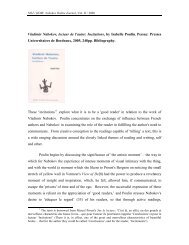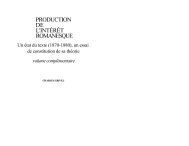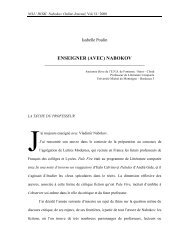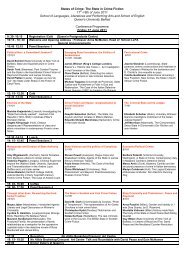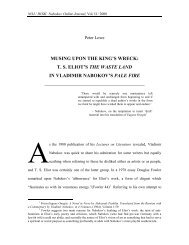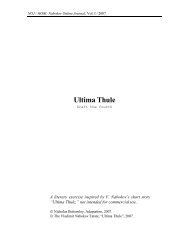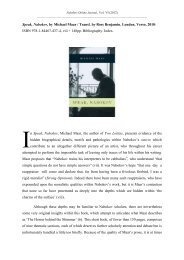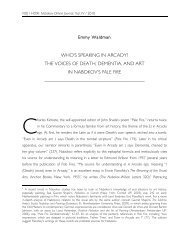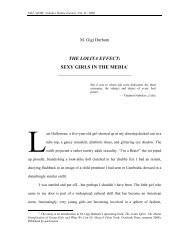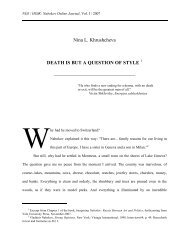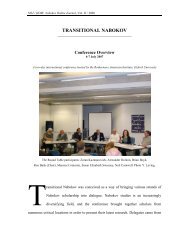domesticated translation: the case of nabokov's translation of alice's
domesticated translation: the case of nabokov's translation of alice's
domesticated translation: the case of nabokov's translation of alice's
Create successful ePaper yourself
Turn your PDF publications into a flip-book with our unique Google optimized e-Paper software.
NOJ / НОЖ: Nabokov Online Journal, Vol. II / 2008<br />
As Connolly notes, Nabokov also used Pushkin’s poem “Gypsies” – <strong>the</strong> line from<br />
“Ptichka Bozhiia ne Znaet” (“God’s Bird Doesn’t Know”) instead <strong>of</strong> <strong>the</strong> parody <strong>of</strong> Isaak<br />
Watt’s “Against Idleness and Mischief” (in Carroll’s “How Doth <strong>the</strong> Little Crocodile”) 4<br />
(1995: 20). In <strong>the</strong> original poem, Watts uses an image <strong>of</strong> a bee as a model <strong>of</strong> hard work.<br />
In Carroll's parody, <strong>the</strong> crocodile is pictured as a deceptive and predatory creature. In<br />
Pushkin’s original poem, <strong>the</strong> image <strong>of</strong> <strong>the</strong> bird is used as a symbol <strong>of</strong> <strong>the</strong> independent and<br />
freedom-loving Gypsies. Translated parody sounds recognizable and funny because<br />
Nabokov, like Carroll, uses <strong>the</strong> image <strong>of</strong> a “cheating,” deceptive crocodile.<br />
Connolly also notes that in order to translate Carrol's “The Lobster Quadrille,” an<br />
original parody <strong>of</strong> Mary Botham Howitt’s “The Spider and <strong>the</strong> Fly,” Nabokov chose<br />
Pushkin’s poem “Pesn’ o veschchem Olege” (“The Song <strong>of</strong> Prophetic Oleg”) (1995:21), a<br />
ballad about a Russian warrior who was foretold that his favorite horse would become a<br />
cause <strong>of</strong> his death. At <strong>the</strong> end <strong>of</strong> <strong>the</strong> poem, Oleg is bitten by a snake that hides in <strong>the</strong> head<br />
<strong>of</strong> his dead horse. Nabokov preserved <strong>the</strong> original rhyme <strong>of</strong> <strong>the</strong> ballad and used <strong>the</strong> key-<br />
word “veshchii” (“prophet”) in <strong>the</strong> first line to make <strong>the</strong> poem more recognizable.<br />
There are two more parodies successfully conveyed by Nabokov which were<br />
described by Demurova (2003: 188-189): Lermontov's poem, “Kazach’ia kolybel’naia”<br />
(“Cossack’s Lullaby”), and a famous folk verse “Chizhyk-Pyzhik, gde ty byl” (“Chizhyk-<br />
Pyzhik, where have you been”). “Cossack’s Lullaby” is used in <strong>the</strong> <strong>translation</strong> <strong>of</strong> lullaby<br />
sung by <strong>the</strong> Queen <strong>of</strong> Hearts (“Speak roughly to your little boy..."), although <strong>the</strong> chosen<br />
poem is not as efficient as “The Lobster Quadrille” because <strong>the</strong> parody remains lyrical<br />
and pompous. Supposedly, Lermontov's poem was not very well-known by children, at<br />
bee.”<br />
4 According to ano<strong>the</strong>r version, this is a parody on <strong>the</strong> child's rhyme “How doth <strong>the</strong> little busy



